Retaining Flavor While Removing Caffeine—a Chemist Explains the Chemistry Behind Decaf Coffee
Decaffeination is a process used to remove caffeine from coffee, preserving the natural flavor and aroma. It has a rich history and is used by almost all coffee producers. Three common methods are used: carbon dioxide, Swiss water, and the Swiss water process.
The carbon dioxide method, developed in the early 1970s, uses high-pressure CO₂ to extract caffeine from moistened coffee beans. The caffeine molecules dissolve in the CO₂, which is then passed through a container of water or over a bed of activated carbon. This step filters out the caffeine and other chemical compounds, which affect the coffee’s flavor. The remaining CO₂ evaporates under heat, and the coffee has minimal CO₂ residue.
The Swiss water process, first used commercially in the early 1980s, uses hot water to decaffeinate coffee. Producers soak a batch of green coffee beans in hot water, which extracts both caffeine and other chemical compounds from the beans. The caffeine concentration is higher in the beans than in the water, so the caffeine moves into the water from the beans. The beans are then placed in fresh water, which has no caffeine in it, and the process repeats up to 10 times until there’s hardly any caffeine left in the beans.
The resulting water contains the caffeine and any flavor compounds that dissolved out from the beans. The filtered water is then used to soak a new batch of coffee beans, allowing the flavor compounds lost during the soaking process to reenter the beans.
The Swiss water process is prized for its chemical-free approach and ability to preserve most of the coffee’s natural flavor. It has been shown to remove 94% to 96% of the caffeine. Both methods have their advantages and drawbacks, but the Swiss water process is considered the most effective and cost-effective method for decaffeinating coffee.
Solvent-based methods are a traditional method used to extract caffeine from green coffee beans. Ethyl acetate and methylene chloride are two common solvents used in this process. The direct method involves soaking the beans in the solvent or a water solution containing the solvent, which extracts most of the caffeine and other chemical compounds with similar solubility to caffeine. The beans are then removed from the solvent after about 10 hours and dried.
The indirect method involves soaking the beans in hot water for a few hours and treating the water with solvent to remove caffeine from the water. Methylene chloride, the most common solvent, forms a layer on top of the water, allowing most of the caffeine to stay up in the methylene chloride layer, which producers can separate from the water.
These methods remove about 96% to 97% of the caffeine. Ethyl acetate is considered safe for decaffeination by the Food and Drug Administration, while methylene chloride is considered unsafe to consume at concentrations above 10 milligrams per kilogram of body weight. However, the amount of residual methylene chloride found in roasted coffee beans is very small, well under the FDA’s limits.
After decaffeination using methylene chloride, the beans are steamed and dried, followed by roasting at high temperatures. This process produces new flavor chemicals from the breakdown of chemicals into other chemical compounds, giving coffee its distinctive flavor.
Some techniques, like the Swiss water process and the indirect solvent method, may reintroduce some extracted compounds, but they cannot return all extra compounds back to the beans, but they may add some of the flavor compounds back.
Read More @ Phys Org
Source: Coffee Talk



